Papers by Nigar Yarpuz Bozdogan

WOS: 000487347700074The objective of this study is to determine the level of awareness of farmers... more WOS: 000487347700074The objective of this study is to determine the level of awareness of farmers about the personal protective equipment used in pesticide applications. The study was conducted in 56 villages in the administrative zone of the central districts of Adana, a southern province of Turkey, during which information was collected from the farmers with the individual interview method. In the individual interviews, demographic properties of the farmers, their behavioural patterns during pesticide applications, general level of knowledge about pesticide applications and level of awareness in the use of personal protective equipment (PPE) were questioned. The farmers included in the scope of the study were 54.14 years old in average and nearly half of them (45.2%) were found to be primary school graduates. The farmers' average history of agricultural activity was 30.19 years, and they had been applying agricultural pesticides for 25.81 years in average. It was determined th...

Imazamox, Türkiye'nin Akdeniz ikliminin etkisi altındaki Osmaniye yerfıstığı tarla toprakları... more Imazamox, Türkiye'nin Akdeniz ikliminin etkisi altındaki Osmaniye yerfıstığı tarla topraklarında oldukçayaygın bir biçimde kullanılan bir herbisittir. Bu çalışmada, iki tip toprak seçilmiş olup, birincisi dahaönceden imazamoxla muamele edilmemiş olan toprak ve ikincisi de imazamox ile muamele edilmiş fıstıktoprağıdır. Bu herbisitin önerilen tarla dozu (40 g L-1etken madde) ve bu dozun 2 ve 4 katı dozları, öncedenimazamoxla muamele edilmiş ve edilmemiş topraklara ilave edilmiştir. Toprakların mikrobiyal aktivitesifarklı nem koşulları altında (tarla kapasitesinin %60 ve %80'i oranında) karbon ve azot mineralizasyonuylaölçülmüştür. Karbon mineralizasyonu 45 gün boyunca 30°C'de CO2respirasyon yöntemiyle ölçümüştür.Tarla kapasitesinin %60'ı ve %80'i ile nemlendirilmiş ve imazamoxun tüm dozlarıyla muamele edilmiş fıstıktoprağındaki karbon mineralizasyon oranları, herbisitle muamele edilmemiş toprakların diğer bütün doznem kombinasyonlarından daha anlamlı bulunmuştur (P...
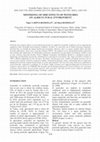
Pesticides have negative effects on environment if pesticides are applied in unsuitable condition... more Pesticides have negative effects on environment if pesticides are applied in unsuitable conditions such as inappropriate equipment, under unsuitable meteorological conditions, overdose, etc, pesticides can be drifted non-target organisms, and then they are harmful for human health and environment. However, there is a major problem before and after pesticide applications: point source pesticide pollution (PSPP). This pollution occurs during filling before application and cleaning after application. For minimizing of pesticide contamination on agricultural environment, biobed is used in some countries especially Sweden, France, England, Guatemala, and Belgium. Biobed is a biological system for minimizing and degrading of pesticide contamination in agricultural environment. The origin of biobed is Sweden in 1990’s. Biobed components are the clay layer, the biomix, and the grass layer. Number of biobeds increases year by year. In some countries, biobed is renamed as biofilter, biomassbe...
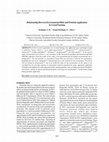
International Journal of Environmental Research, 2015
The aim of this study was to determine the environmental risk of pesticide a.i. applied to contro... more The aim of this study was to determine the environmental risk of pesticide a.i. applied to control insects and fungus in cereal farming in Sanliurfa, Turkey. In 2013, 8 active ingredients (a.i.) in cereal farming were applied for insect and fungus control in Sanliurfa, Turkey. These a.i. were alpha-cypermethrin(EC), chlorpyrifos(EC;WP), difenoconazole(EC), indoxacarb(WG), lambda-cyhalothrin(EC), lufenuron(EC), propiconazole(EC) and tebuconazole(DS). In the present study, environmental risk of these a.i. was calculated via The Pesticide Occupational and Environmental Risk (POCER) indicators. From the results of this study, it was determined that the highest environmental risk is chlorpyrifos(EC). For this pesticide a.i., Exceedence Factor (EF) was assessed as 3.446 for the environment. Regarding the total score, chorpyrifos(EC) had potential risk as 49.2 percent for the environment. The lowest risk was found for tebuconazole(DS) due to its 0.000 EF value for the environment. In this ...
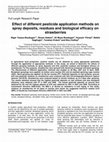
African Journal of Agricultural Research, Feb 4, 2011
In agricultural food production, positive results can be obtained by using appropriate pesticides... more In agricultural food production, positive results can be obtained by using appropriate pesticides through the application of appropriate methods. In this study, we aimed to determine the effects of different spraying methods on spray deposits and drift, pesticide residues and biological efficacy on strawberries. For this purpose, strawberries were sprayed with dicofol by broadcast and band spraying. The effectiveness of different application methods was studied on 09 May, 2007 and 16 April, 2008. Broadcast sprayings were applied via hollow cone nozzles (HC) and air-assisted spinning cage nozzles (ASC). Band spraying was applied via flat fan nozzles (FF). Pesticide deposits on leaf surfaces, ground, drift and pesticide residues on strawberries were analyzed with Gas Chromatography/Electron capture detector (GC/ECD). Strawberries were analyzed based on dicofol residues up to 6 days after spraying. The results obtained showed that the highest pesticide deposits on leaf surfaces and also biological efficiency were obtained with FF in 2007 and 2008. The lowest pesticide deposits on ground were obtained by HC and the highest deposit of drift was obtained by ASC in 2007 and 2008. According to Commission Directive 2000/42/EC, the MRL's of dicofol on strawberry is 0.02 mg/kg. In this study, residues on strawberries for all types of nozzles were below the suggested maximum residue level (MRL) of dicofol by Commission Directive 2000/42/EC in 2007 and 2008.
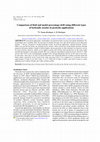
International Journal of Environmental Science & Technology, 2009
In pesticide applications, small droplets are desired for better coverage and uniform distributio... more In pesticide applications, small droplets are desired for better coverage and uniform distribution. Yet, small droplets have a problem: Drift, the movement of droplets off-target. Low drift nozzle produces fewer drift-prone droplets, < 100 µm, compared to standard hydraulic nozzles. In pesticide applications, standard hydraulic nozzles, hollow cone and flat fan nozzles are generally used by farmers. These nozzles have broad droplet spectrum and high proportion drift-prone droplets. Sample of drifted droplets and measurements in field conditions are expensive and can be time-consuming. However, models can be applied to predict drift without field measurement. In this study, model and field measurement of percentage pesticide drift were compared using different hydraulic nozzles, D4-45, F 11006 and low drift 11003 by gas chromatography equipped with a nitrogen-phosphorus detector. In the result of this study, for all nozzles, values up to 2 m and 3 m showed that there were statistically different according to German model and Dutch model, respectively. In the result of this study, percentage drift at 5 m compared to 1 m distance decreased approximately 15 folds in low drift 11003, 12 in F 11006 and 10 folds in hollow cone D4-45 nozzles in actual application and 5 folds in German and 9 folds in Dutch models.
Crop Protection, 2005
... Artificial plants placed under the nozzle at 20 cm intervals in a single row were made from c... more ... Artificial plants placed under the nozzle at 20 cm intervals in a single row were made from cotton fabric, to represent a cotton canopy with a Leaf Area Index (LAI) of 2. The leaves of the artificial plants attached to the stem with special wires were flexible. ...
Fresenius Environmental Bulletin, 2008
In pesticide applications, pesticide deposition on environment, human and other organisms, can be... more In pesticide applications, pesticide deposition on environment, human and other organisms, can be reduced by using appropriate pesticides through the application of appropriate application technique. Hollow cone nozzles(HC), air-assisted spinning cage nozzles(ASC ...

The aim of this study was to assess the occupational exposure for operator and worker by using ri... more The aim of this study was to assess the occupational exposure for operator and worker by using risk indices in herbicide application in Adana, Turkey. The data of herbicides active ingredient (a.i.) related to applications in soybean, corn, cotton, and sunflower cultivation in Adana, 2014, were obtained by calculation of risk index (RI) and exceedence factor (EF) for operators and workers with Personal Protective Equipment (PPE) and without PPE according to the Pesticide Occupational and Environment Risk Indices (POCER). In the result of this study, it was assessed that there were no maximum risk (EF<1) in soybean, corn, cotton, and sunflower cultivation for operators. It was determined that operators were under intermediate risk (60%), and low risk (40%). On the other hand, some a.i. have maximum risk for workers (60%). For workers, PPE was decreased 32% in maximum risk, 44% in intermediate risk and, yet, increased 24% in no risk. In this study, it was concluded that PPE has to be used for minimizing pesticide exposure on workers. It was found that PPE was important for workers in all herbicide applications. Copyright © by PSP and PRT
Crop Protection, 2004
Overall application of herbicides with hollow cone nozzles is common practice in second-crop maiz... more Overall application of herbicides with hollow cone nozzles is common practice in second-crop maize in the Cukurova Region of Turkey. Effective integrated weed management tactics are needed for this region. Acetochlor and nicosulfuron, two commonly used herbicides in maize ...
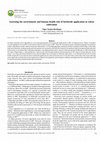
Journal of Food Agriculture & Environment, 2009
In Turkey, herbicide active ingredient (a.i.) was used approximately 25% in pesticide application... more In Turkey, herbicide active ingredient (a.i.) was used approximately 25% in pesticide applications in 2007. In Adana province, Turkey, 10 numbers of active ingredients were used for weed control in wheat cultivation areas in 2007. These are: fenoxaprop-p-ethyl, clodinafop-propargyl, mesosulfuronmethyl, iodosulfuron-methyl-sodium, florasulam, flumetsulam, 2,4-D acid dimethylamin, tribenuron-methyl, triasulfuron and dicamba. In this study, total risk of herbicide on human health and environment were assessed by POCER (The Pesticide Occupational and Environmental Risk) indicator. In this study, it was obtained that clodinafop-propargyl a.i. has high potential risk for worker (1.000) and operator (0.909) due to 1.000 of maximum EF values. Flumetsulam a.i. and triasulfuron a.i. have no total risk for human health and environment due to 0 EF values in all risk indicators. In this study, it was shown that human health has been affected higher than environment in herbicide applications. It ...

Pesticides are extensively used for controlling pests in agriculture. Point source pesticide poll... more Pesticides are extensively used for controlling pests in agriculture. Point source pesticide pollution has potential damage on environment during filling, mixing, and cleaning spraying equipment. Biobed, originated in Sweden, is a biological pit which is used for reducing pesticide contamination to environment during filling, mixing, and cleaning of sprayers. The aim of this study was to determine of pesticide absorption and degradation of malathion, dichlorvos, and fenthion active ingredients in biobed and farm-soil, and comparation of these conditions. The biomixture in biobed was prepared by mixing soil, peat and wheat straw in the volumetric proportions of 1:1:2, respectively. In this research, biobed and farm-soil samples were taken at 0-15, 15-30 and 30-50 cm for determination of pesticide concentration. Biobed and farm-soil samples were taken for each chemical treatment at trial days, and 7, 14, 21, 28, 35, 42, 49, 56, 63 and 70 days after treatment. All chromatographic analy...
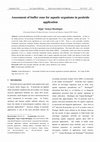
International Journal of Agricultural and Biological Engineering, 2016
In pesticide applications, the buffer zone helps to protect water sources against pesticide conta... more In pesticide applications, the buffer zone helps to protect water sources against pesticide contamination. In 2014, in the Adana province, the percentage of herbicides used was approximately 12% in corn, sunflower, soybean and cotton. To control the weeds, fifteen active ingredients (a.i.) were used in these crops in 2014. These a.i. were acetochlor, aclonifen, benfluralin, bromoxynil, clethodim, dicamba, fluazifop-p-butyl, foramsulfuron, linuron, mesotrione, nicosulfuron, oxyfluorfen, prometryn, trifluralin and tritosulfuron. The aim of this study was to assess the risk of these herbicides on aquatic organisms and estimate buffer zone distances for the above agricultural crops in herbicide application. Risk index (RI) values were calculated according to German Drift Model (GDM) and Dutch Drift Model (DDM). Consequently, buffer zone needs for herbicide application of five a.i., namely acetochlor, benfluralin, linuron, prometryn, and trifluralin, were determined in this study. Result...

Turkey is one of the biggest cotton producing countries in the world. Defoliant is applied on 17%... more Turkey is one of the biggest cotton producing countries in the world. Defoliant is applied on 17% of the Turkey cotton production, which is similar to average defoliant application in the world. In Turkey, Finish ® and Dropp ® are widely in use as defoliant for desired boll opening in cotton. Finish ® contains ethephon a.i. and cyclanilide a.i., and Dropp ® contains thidiazuron a.i. and diuron a.i. In this study, total risk of defoliant on human health and environment were calculated by POCER (The Pesticide Occupational and Environmental Risk) indicator. The objective of this study was to determine the total risk value of defoliant application in cotton on human health and environment in Turkey. Thidiazuron a.i. has no potential risk on human health and environment. Diuron a.i. has relatively low total risk value on human health. Yet, it has very low risk on environment (0.097). Ethephon a.i. has relatively high total risk on human health (1.550). Cyclanilide a.i. has total risk on ...
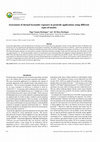
In pesticide applications, pesticide deposition on off-target can be reduced by using appropriate... more In pesticide applications, pesticide deposition on off-target can be reduced by using appropriate nozzles. In this study, the effects of different types of nozzles were investigated pesticide deposition on bystander to malathion. The application rate of trials was 200 l ha -1 . In the trials, the hollow cone nozzles (HC), the flat fan nozzles (F), and the low-drift flat fan nozzles (LD) were used. Malathion was applied as 0.570 kg a.i. per ha in the trials. The dermal bystander exposure was measured by using the whole body dosimetry technique. In the trials, the total body area of bystander overalls was approximately 2 m 2 . All chromatographic analysis was performed on gas chromatography with equipped a nitrogen-phosphorus detector (GCNPD). Pesticide deposition found in each one of the body parts in F-nozzles was higher than LD and HC nozzles. The lowest pesticide deposition on bystander was found in LD nozzles. Totally, the lowest dermal deposition was obtained as 5.972 µg kg -1 i...
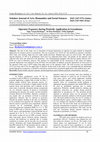
The aim of this study was to determine of dermal deposition on operator by patch method in fungic... more The aim of this study was to determine of dermal deposition on operator by patch method in fungicide application for tomatoes grown in greenhouse. The size of patches was 10x10 cm 2 and attached on operator’s shoulder, chest, back, arm, forearm, thigh, leg, foot, ankle, hands and mask. Standard spray gun was used in trials. The operator sprayed distances of 200 m in greenhouse. Each trial was replicated three times. All patches on the operator were collected after trials and analyzed in the laboratory. Gas chromatograph equipped with electron capture detector (GCECD) was used in laboratory analysis. The operator was right-handed. In the conclusions of this study, the highest pesticide depositions were obtained on the left hand, foot and ankle. In addition, pesticide depositions on lower parts of the operator's body were 9.205% higher than upper parts of the operator's body. The total recovery was determined 52.2% for lower and 47.8% for upper body of operator. In the result ...











Uploads
Papers by Nigar Yarpuz Bozdogan